|
|
|
Sort Order |
|
|
|
Items / Page
|
|
|
|
|
|
|
| Srl | Item |
| 1 |
ID:
158410
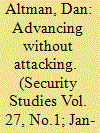

|
|
|
|
|
| Summary/Abstract |
What is the nature of the strategic game that states play during crises? Extensive research examines the leading answer: coercive bargaining. States prevail by signaling resolve, establishing the credibility of their threats, and coercing their adversaries into backing down. However, instead of (or in addition to) traditional coercive bargaining, this article shows that states frequently play out a different game with its own set of rules and tactics. The article explores how states outmaneuver their adversaries: working around their red lines, taking gains by fait accompli and imposing pressure where it is possible to do so without quite crossing the line of unambiguously using force. Based on this premise, the article develops a theoretical framework for understanding strategic interaction during crises, referred to as advancing without attacking, and shows that it best explains the course of the Berlin Blockade Crisis of 1948–49 while also shedding light on other prominent crises.
|
|
|
|
|
|
|
|
|
|
|
|
|
|
|
|
| 2 |
ID:
157551
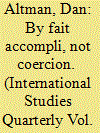

|
|
|
|
|
| Summary/Abstract |
In February 2014, Russia decided to wrest the Crimean Peninsula from Ukraine. Moscow could have threatened to attack Ukraine if Kiev failed to relinquish Crimea. However, Russia did not attempt coercion. Russia unilaterally occupied and annexed the territory, gambling that it could take Crimea without provoking war. This alternative strategy—the fait accompli—receives little scholarly attention. At issue is a fundamental question of statecraft in international politics: How do states make gains? By coercion or by fait accompli? Territorial acquisitions offer the best single-issue domain within which to address this question. Using new data on all “land grabs” since 1918, this research note documents a stark discrepancy. From 1918 to 2016, 112 land grabs seized territory by fait accompli. In that same span, only thirteen publicly declared coercive threats elicited cessions of territory. This fact suggests that the fait accompli deserves a larger role in the field's thinking about strategy and statecraft on the brink of war. It carries with it important implications for canonical theories of war that rely on assumptions about coercive bargaining during crises.
|
|
|
|
|
|
|
|
|
|
|
|
|
|
|
|
| 3 |
ID:
172831
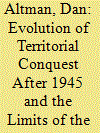

|
|
|
|
|
| Summary/Abstract |
Past studies conclude that a territorial integrity norm caused territorial conquest to decline sharply after 1945, virtually subsiding after 1975. However, using new and more comprehensive data on territorial conquest attempts, this study presents a revised history of conquest after 1945. Unlike attempts to conquer entire states, attempts to conquer parts of states remained far more common than previously recognized. More than conquest declined in frequency, its relationship with war evolved. Challengers attempting conquest before 1945 often initiated a war, then sought to occupy large territories. Today, challengers more often seize small regions, then attempt to avoid war. Adopting this strategy, the fait accompli, challengers increasingly came to target territories with characteristics that reduce the risk of provoking war—such as a low population and the absence of a defending military garrison—but challengers nonetheless take a calculated gamble. In part because seizures of smaller territories with such characteristics have not declined, the operative constraint appears to be against war-prone aggression, not territorial revision. The evolution of conquest is a symptom of war's decline, not its cause. Most of the evidence that the territorial integrity norm suppressed conquest or war withers under investigation with new data. Attempts to get away with seizing small pieces of territory are likely to be a defining element of the twenty-first-century international security landscape.
|
|
|
|
|
|
|
|
|
|
|
|
|
|
|
|
| 4 |
ID:
193175
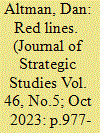

|
|
|
|
|
| Summary/Abstract |
Using declassified materials to examine the eleven red lines of the Cuban Missile Crisis, this study qualifies and amends two popular beliefs about them: failing to punish violations damages credibility and deterrence requires declaring unambiguous red lines. I argue, first, that violations of red lines create fleeting ‘windows of credibility’ wherein violators fear retaliation. If declarers move quickly, they can convert non-enforcement into a bargaining chip, exchanging it for concessions while avoiding escalation. Second, rather than wholly embrace clarity or ambiguity, declarers frequently optimize by combining clear demands with ambiguity about the consequences of crossing those lines.
|
|
|
|
|
|
|
|
|
|
|
|
|
|
|
|
| 5 |
ID:
157825
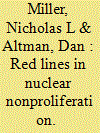

|
|
|
|
|
| Summary/Abstract |
States that seek to prevent nuclear proliferation through threats of force or sanctions often set “red lines,” which set limits on nuclear capabilities beyond which a proliferator must risk triggering a punitive response. Yet despite a wide range of possible red lines that states could choose—for example, constructing a nuclear weapon (weaponization), enriching uranium, or conducting a nuclear test—the academic literature is nearly silent on the tradeoffs inherent in selecting one of these red lines over another. Specifically, what are the vulnerabilities in each red line that proliferators can exploit to advance their nuclear program while limiting the punitive response? To address this question, this article introduces a theory of red lines and how they are challenged. We apply this theory to red lines in nuclear nonproliferation and offer historical evidence to support it.
|
|
|
|
|
|
|
|
|
|
|
|
|
|
|
|
|
|
|
|
|